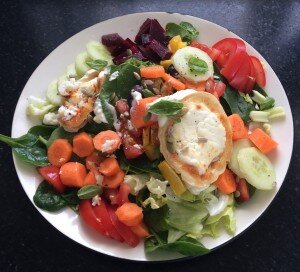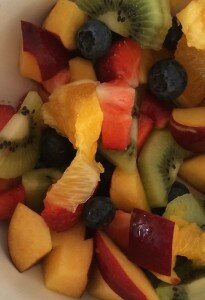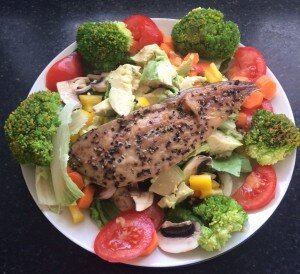Nutrition: My 6 steps for maximum energy and a healthy lifestyle
Nutrition is key to athletic performance, especially in endurance sport when I run long distance or spend the day climbing. It is one of the many facets of training, alongside technique, strength and mental preparation. I’m not a nutritionist but I’ve learnt over the years what to eat and when to eat it in order for me to feel good, be healthy and maximise my performance.
There are many aspects of sports nutrition, including what to eat before a race, during a race (especially important in long endurance events), and after a race to recover faster. However, to start in this first article on nutrition, I will take a step back and focus on the basics.
Nutrition for me, is all about lifestyle choices and eating healthy food on a regular basis, rather than dieting. I don’t follow a strict nutrition routine. I do however focus on the type and quality of the nutrients I eat, i.e. carbohydrate, protein, and fat. They all contain calories that my body uses for energy. So I balance these nutrients in a healthy diet and it enables me to fuel my body to perform efficiently.
So what do I eat?
Here is an example of a daily menu.
Breakfast:
Fresh fruit salad (seasonal fruits when possible)
Toasted rye bread with almond butter
Goat’s Cheese Salad
Lunch:
Salad with leafy greens and lots of other fresh seasonal vegetables (plenty fresh tomatoes from the garden at the moment!). I add heathy fats (like avocado, nuts, olives) and a source of protein (smoked fish, goat’s cheese…).
Or Homemade soup sometimes in the winter with rye bread.
Snacks:
Fruit, Greek yogurt with maple syrup, Muesli, Whole wheat bread with almond butter or honey, Homemade backing such as banana bread
Dinner:
Hot meal including a source of protein (chicken, fish, eggs, lentils…), complex carbs (brown rice, quinoa….) and lots of fresh veggies.
If I’m stull hungry, I have a fruit and/or dark chocolate with nuts a bit later.
My Key Nutrition Rules
1. Read the Labels
I pay a lot of attention to what ingredients are in the products I buy. I read the labels of the products before buying them to make sure they satisfy my requirements.
2. Choose Complex Cards
YES: I eat complex carbs from unrefined sources (non-processed). I eat a lot of fruits, vegetables, brown rice, lentils and pulses, beans, quinoa, rye bread or whole wheat bread. These are the slower acting carbs that prevent me from feeling hungry for longer.
AVOID: I avoid simple carbs such as white flour or white sugar as much as possible. I of course make exceptions once in a while
3. Eat Healthy Fats
I eat plenty fats. However, there are various types and some are better for you than others.
YES: I primarily choose to eat mono-unsaturated or poly-unsaturated fat. These fats are the “good fats”. Mono-unsaturated fats are especially healthy because they lower the bad cholesterol (LDL) in your blood. These fats include olives (I cook everything in olive oil), avocado and nuts.
Other types of fats include limit saturated and trans-fats. Saturated fats are found in foods that come from animals, such as meat and dairy products. Being French, I love cheese! I favour goat’s cheese to other cheese made of cows’ milk as it is lower in cholesterol and fat than other cheese made of cow’s milk.
AVOID: However, I try to stay away completely from hardened fats, such as palm kernel oils as well as oils that have been hydrogenated. Also, I avoid trans-fats are found in most processed foods and fried fast foods.
4. Go Lean on the Proteins
Protein is needed by the body for growth, maintenance, and energy. Protein can also be stored and is used mostly by our muscles.
YES: Fish is one of my favourite source of protein.
For sources of protein as well as saturated fats, I eat lean meat (chicken or turkey), salmon, mackerel and cheese. I also eat red meat but less regularly, approximately once a fortnight. Finally, one of my favourite source of protein and healthy fats is nut butter, especially almond butter! I have it every morning on my toasted rye bread!
5. Don’t forget about Vitamins and Minerals
The body needs vitamins and minerals and we all have different requirements. I try to ensure I eat a large variety of minerals (like calcium, iron, and sodium) and vitamins (Vitamin C …).
Most importantly, I listen to my body and I adapt my diet accordingly. I’ve learnt to identify when my body craves salt or sugar. Or for example I know that often, when I feel particularly tired, my body lacks iron.
When I am ill or I feel I may be coming up with a virus, I take some multi vitamins supplement to help my immune system fight the germs.
6. Stick to the classic 3 meals and 1-2 snacks per day
For me, I find that eating the standard 3 meals per day, plus a snack or two in the afternoon or before a strenuous training session works best.
I tweak the timing of my meals according to when I train each day. For an intense training session, I will eat some carbs about an hour before (e.g. whole wheat toast with honey). And I try to have a meal shortly after a training sessions (within 20-30mins) to help with the recovery.
Finally, I adapt what I eat depending on the specificity of my training and racing/competitions. I’ll write about that in more details in later articles.
In the meantime, chose the products that are right for you and enjoy what you eat It’s all part of the journey!
#FollowYourPassion



